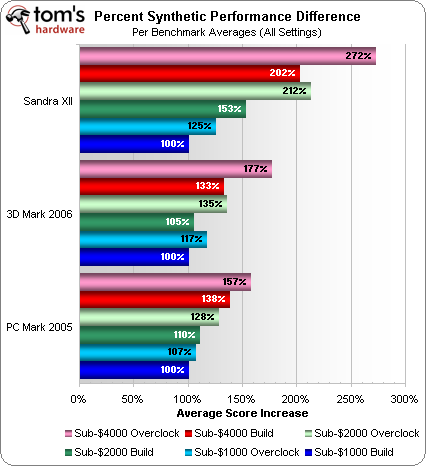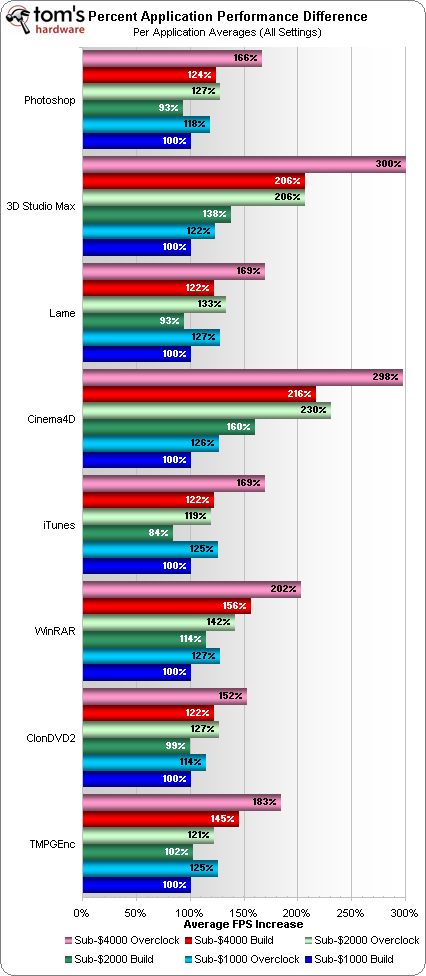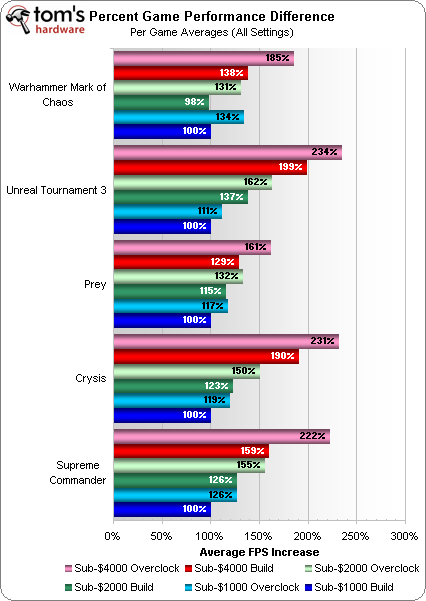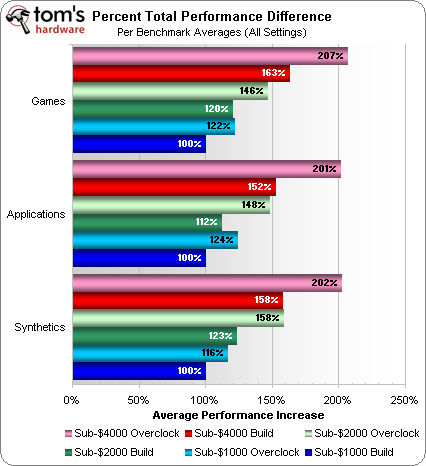System Builder Marathon: Price/Performance
Benchmark Summary Analysis

While the synthetics didn’t seem to reflect the real-world performance differences in all cases, 3DMark was pretty close. Sandra and PCMark seemed to favor the sub-$2,000 system’s four cores more than actual applications bore out, making the sub-$2,000 system appear better than it was.

Real-world applications demonstrate that the majority aren’t making use of multiple CPU cores, showing the sub-$1,000 PC to be an excellent deal in this regard. The only true exception seems to be 3D rendering applications like 3ds Max or Cinebench. If you use these software packages, you do yourself a disservice unless you purchase a quad-core CPU. Other than that, the over clocked sub-$4,000 PC is a wonder to behold, displaying a clear and undeniable advantage that it’s high over clock provides.

When we group the game results together we can see some clear trends. As mentioned, Warhammer Mark of Chaos seems to be the only title in our benchmarking suite that doesn’t appreciate multiple CPU cores; all of the other titles show pretty consistent scaling, and we see that in some cases the four-GPUs in the sub-$4,000 system’s 9800 GX2s are really being put to work.

This chart brings it all together and gives us a broad overview of actual performance differences between the three system builder marathon machines. At stock clocks the sub-$2,000 PC has about a 15% lead over the sub-$1,000 PC, and the sub-$4,000 PC has about a 50% lead over the cheapest rig. As you can see, this does not correlate with the cost, leading us to the performance per dollar benchmarks…
Get Tom's Hardware's best news and in-depth reviews, straight to your inbox.
Current page: Benchmark Summary Analysis
Prev Page Game Benchmarks – Real Time Strategy Next Page Value AnalysisDon Woligroski was a former senior hardware editor for Tom's Hardware. He has covered a wide range of PC hardware topics, including CPUs, GPUs, system building, and emerging technologies.
-
L1qu1d Really shocked at how much of a benefit the 4000$ computer did when Overclocked:| Especially in Crysis, WOW!Reply -
zipz0p And yet it's still smashed in bang/buck.Reply
I like the introduction of the high-resolution gaming bang/buck chart - it's a keeper! -
sublifer Great charts. Still though... not a whole lot of value since we've gotten new video cards out. I know its unreasonable to expect the entire thing to be redone with the new components, but at the same time, many people (yes, me too....) would like to see how the outlook might change with the new graphics cards. Is there any way you could substitute appropriately (by that I mean cost) in a few of the systems and compare them with the sbm results?Reply
Thanks again guys! -
gwolfman What's interesting is that the $2000 build overclocked was able to return slightly above (or slightly below in hi-res gaming) it's value compared to the original build. That means that ever dollar spent is rewarded back with an equal system performance increase. Very interesting.Reply -
beerzombie I think comparing performance/price with overclocked systems when the price of aftermarket cooling solutions are included in the non-overclocked system is a bit misleading. I feel that the reality is that the Sub $4k PC is $256 cheaper when not overclocked, and the sub $2k machine should be $120 cheaper as well as the $1k PC being $26 cheaper. It is just unrealistic to assume someone is watercooling a PC and won't be overclocking it.Reply -
zipz0p Interesting point, BeerZombie. I would like to see the price/performance comparisons again taking that into account!Reply -
gaiden Interesting, according to the Hi-res bang/buck value overclocking a sub$2000 will increase the value by 26% while sub$1000 o.c. will increase by 36% ! This is a very useful stat indeed and i agree with others that it's a keeper for sure. So in conclusion it makes sense that to get the most out of your config vs $ you spend should be anywhere between the $1000-$2000 with o.c. which probably represents majority of the ppl out there. < (pointless, but nice to hear statement) :)Reply -
Preclude The parts are not relevant. What people are missing here is the overall message. They are trying to visually display the aspects of price to performance in the PC market for custom builds. The data will always be relevant no matter what the hardware goes to. There will always be the "best performing budget rig", the "step up medium high end build" and the "Not really worth the money but if you want it you want it" builds. I'm sure some could argue builds between those, but you will always find that builds fall near one of those general areas.Reply
TL;DR Thanks Toms, anyone who actually builds systems on a regular basis can appreciate this data. -
Kirth Gersen What you can take away from this is that you are very much in the realms of the law of diminishing returns with a $4k system from a gaming perspective. 30FPS is plenty, your eyes can't perceive better, so what is the point of a system which can achieve 80FPS? At least a Ferrari might improve the sex life :).Reply
A mid range $2k system has always been my price point. For that you can usually build an overclocked system which hits 30FPS on max graphics.